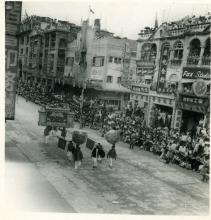Hong Kong's 'shelter areas'
Primary tabs
Along stage 2 of the Wilson Trail, you'll pass a strange collection of eight low, brick platforms [1]. Each has a concrete top with 8 circular holes – 4 large and 4 medium size. Further on you'll pass a similar single platform, with just two holes cut in the top.
The information board by the single platform suggests they were built in 1938/39 as cooking stoves (the round holes are just the right size right for a wok), as part of a plan to feed the people of Shau Kei Wan in time of war. Photos on the internet refer to them as the 'japanese stoves', suggesting they were built during the Japanese occupation. From what I can find, neither explanation is quite right.
The first explanation is closer. I believe the stoves were built as part of a 'shelter area'. These were one of Hong Kong's preparations to protect its civilians in time of war. (Other preparations included building pen shelters, tunnels, and trench shelters.)
The earliest mention I've found of “shelter areas” is from an article on 8th September 1940 [2], introducing these preparations to the public. It describes splitting Hong Kong Island into shelter areas, and continues:
The “shelter areas” it is proposed, will be located on hillsides, and in the event of a possible air attack on the Colony, people residing in the neighborhood of these “areas”, will be advised to leave their homes, where no protection has been provided, and proceed to the “shelter areas” where they will remain until the danger has passed.
Government will provide materials in the “shelter areas” for the erection of temporary dwellings. Pipes will be laid to supply water.
As they were still only 'proposed' at that time, we can say that the stoves were most likely built sometime between September 1940 and December 1941.
So far I haven't found a firm description of how many areas were created. There were definitely more than one though [3]:
Just below our house [Maryknoll, in Stanley] to the north, the British Government had constructed, as it had in many other places on the island, a refugee camp. Here three large godowns had been erected and just been filled with stores of rice, peanut and coconut oil for cooking purposes. A large open air kitchen also had been constructed, containing about sixty large fireplaces [cf. 64 fireplaces at the Wilson Trail site] with the usual Chinese wok t'au or rice cauldrons, and close by, a huge pile of firewood had been built up. Simple, fabricated refugee shelters had also been planned, but they had not yet been erected. The plan seemed to be that in case of intense bombing or bombardment of the city, the inhabitants could come out to Stanley during the day and stay at these camps, returning at night to their homes, but as a matter of fact, the camps were never put to much use.
I still wonder how these areas were expected to be used. The idea of commuting from the city to one of these shelter areas on a daily basis doesn't seem practical.
Maybe the government was expecting people to just move out from the city and stay in these shelter areas while an extended battle was fought? That would explain the large godowns, 'filled with stores'. Elsewhere we read that “Hongkong had been stocked with supplies for 6 months” [4]. So on Dec 7th 1941, when the Governor broadcast that “Kowloon would be held for a month, and Hong Kong for three months” [5], maybe he really believed it?
I haven't found much information about these shelter areas - just what you see above. I'm hoping you'll be able to add some more. I'm also interested to know whether any more of the old stoves have survived at other locations around Hong Kong?
David
References:
- [1] There are some photos on Picasa that show what the stoves look like.
- [2] Hong Kong Sunday Herald, Page 12, 8th September 1940
- [3] Page 47, The Maryknoll Mission, Hong Kong 1941-1946.
- [4] Page 86, Hong Kong, Dec 41 - Jul 42, by A.D. Blackburn
- [5] page 283, Wings for an Embattled China, by W. Langhorne Bond, James E. Ellis


Comments
Shelter Areas
re: Shelter Areas
More about the stoves
Thanks to T & Craig for more information about these.
T introduced a book with more info:
Craig has the book, and gave us the relevant section:
He also notes:
I think it's very unlikely that the 'caves' were to be for storing food. The Maryknoll description, and another description in 'Prisoner of the Turnip Heads' both talk about Godowns (warehouses) stocked with food. I can't imagine they'd have used damp, narrow tunnels as storage areas.
Kitchens
Wok stoves
The large wok stoves built for the shelter areas seem strange when we're used to cooking in a kitchen. Then last week on a hike from Tung Chung to Tai O we passed these stoves near San Tau village. Only space for two woks, but otherwise very similar to the stoves you can see in the shelter areas along the Wilson trail.
Re: Wok Stoves in local villages
Hi there,
Wok stoves of various sizes are actually quite common in local villages among farmers.
Best Regards,
T
Re: Wok Stoves in local villages
Hi T,
Any idea what they are used for? Just for daily cooking, or for some sort of special occasion?
Regards, David